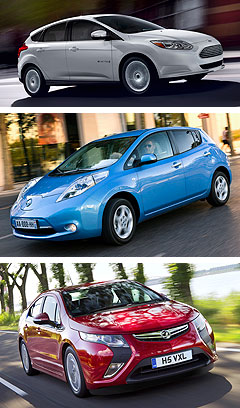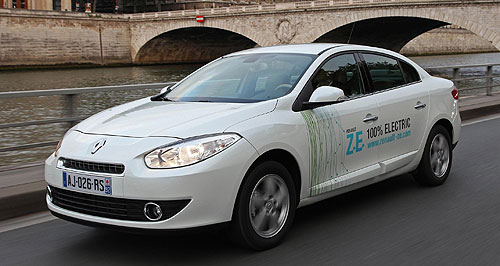Make / Model Search
News - General News - Electric VehiclesConcern over global EV salesiOn the prize: France has been very successful luring buyers into low or zero--emission cars like the Peugeot iOn EV. Governments project seven times more EV and PHEV sales than car-makers plan to build19 Mar 2012 By IAN PORTER ONLY a few governments around the world are actively encouraging the take-up of low-emission vehicles, but the success of the programs is varied, according to the International Energy Agency. In Europe, France has achieved spectacular success with its bonus/malus (good/bad) scheme based on tailpipe emissions, but China has achieved very little success in encouraging the take-up of electric vehicles. “There are some early signs of progress, but much more needs to be done,” said Tali Trigg, who heads up the IEA’s Electric Vehicle Initiative. Mr Trigg also noted a yawning gap between the number of EVs and plug-in hybrid EVs (PHEVs) that governments expect to see on the roads and the number that car-makers think they will sell. He said that the projections for EV and PHEV sales made by governments around the world amount to seven million in 2020, with the global car park of EVs and PHEVs by then amounting to 23 million vehicles. However, when the IEA aggregated all the EV production plans from the car-makers, the total expected output in 2020 was little more than one million units. “If we compare that sales target against announced manufacturing capacity, you can see there is a gap,” Mr Trigg told the Cars of Tomorrow conference in Melbourne last week. He believes there was no cause for alarm yet, but governments “clearly needed to talk to manufacturers” in a bid to align the two projections more closely. “It may just be that auto-makers are assuming a cautious roll-out. It’s a new market it makes a lot of sense. “There’s no cause for alarm per se, but it is interesting to put these next to each other, especially in a room with auto company and government representatives.”  From top: Ford Focus electric, Nissan Leaf, Opel Ampera. From top: Ford Focus electric, Nissan Leaf, Opel Ampera.The IEA accepts the findings of the Intergovernmental Panel on Climate Change and supports the call for CO2 emissions to be reduced 50 per cent from 2009 levels by 2050. Mr Trigg said meeting this target would require a global energy technology revolution that would see, among other things, a major switch in energy use and technology in cars and trucks. “There’s no one solution. We need to do several things mode-shifting, more efficient fuels and different types of vehicles.” The French system of incentives and penalties is designed to encourage buyers to purchase lower-emission vehicles and has been a great success, he said. Under the scheme, cars emitting between 131 and 160 grams of CO2/km are not taxed or penalised. Cars emitting more than that are taxed more as the emissions rise so, if your car emits more than 250g/km, you are slugged €2600 ($A3230). Conversely, if your car emits less than 131g/km, you get a rebate. If your car is rated at less than 60g/km – essentially an EV or plug-in hybrid – you receive a bonus of €5000 ($A6210). Mr Trigg said that, when the scheme started in 2008, cars emitting less than 120g/km accounted for 20 per cent of the French market. By the end of 2009, after less than two years, more than half of all cars sold in France came under that figure. “The impact of the program was immediate and lasting,” said Mr Trigg. “The program is widely considered a success, although it didn’t achieve the revenue neutrality it aimed for.” In fact, bonuses paid to buyers exceeded the total penalties levied by €214 million in 2008, €525 million in 2009 and €497 million in 2010. Not surprisingly, the bonuses were consequently revised down for 2011 and 2012. Mr Trigg said the success of the program was partly due to good consumer education. Labelling of all new cars was compulsory in dealerships. “As of 2009, France had Europe’s most efficient vehicle fleet as the number of vehicle models meeting the standards has steadily increased.” For instance, at the end of 2007 Peugeot offered 89 models that emitted less than 130g/km, but two years later that number had more than doubled to 209. At Renault, the number went from 86 to 182, VW went from 56 to 150 and, at the premium end of the market, BMW went from 18 to 56 models and Mercedes-Benz from 28 to 44. Concerns about the take-up of EVs were further expressed in the Melbourne conference during a panel discussion. Former Toyota Australia executive chairman John Conomos, also a former member of the Toyota parent company board of directors, said Chinese car buyers appeared to be unenthusiastic about EVs, even though they had never driven a petrol car and could have no prejudices. “If we look at China, where they have got enormous incentives under the current five-year plan for consumers in 21 of their cities, you can get an $8000 rebate – half from central government, half from provincial government – if you buy an EV,” said Mr Conomos. “They’ll put a charging outlet in your home or apartment and they’ll forgive your electricity charges for life (but) that has not had the desired effect to meet the 500,000 sales they want. “You can legislate and you can push, but if these consumers are not ready…“These are first-time buyers and they don’t have prejudice because they have never owned a petrol car. Therefore there’s a huge risk to go ahead in mass production.”  Read more12th of December 2011  Every Nissan EV ‘profitable’Nissan CEO Carlos Ghosn reveals Leaf and future EVs will make plenty of money24th of October 2011  Zoe aims to be global EV bestsellerRenault hopes its upcoming Australia-bound electric light car will be a top-seller21st of July 2011  No EVs in sight for Toyota in OzToyota Australia sticks to hybrids as US goes for EV RAV4 and iQ |
Click to shareGeneral News articlesResearch General News Motor industry news |











Facebook Twitter Instagram